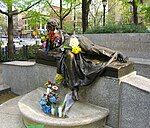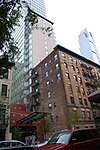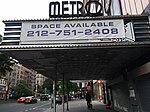103rd Street station (IRT Broadway–Seventh Avenue Line)

The 103rd Street station is a local station on the IRT Broadway–Seventh Avenue Line of the New York City Subway. Located at the intersection of 103rd Street and Broadway on the Upper West Side of Manhattan, within Manhattan Valley, it is served by the 1 train at all times. The 103rd Street station was constructed for the Interborough Rapid Transit Company (IRT) as part of the city's first subway line, which was approved in 1900. Construction of the line segment that includes 103rd Street began on August 22 of the same year. The station opened on October 27, 1904, as one of the original 28 stations of the New York City Subway. The station's platforms were lengthened in 1948, and the station was renovated in the 2000s. The 103rd Street station contains two side platforms and three tracks; the center track is not used in regular service. The station was built with tile and mosaic decorations. The mezzanine above the platforms contains exits to 103rd Street and Broadway.
Excerpt from the Wikipedia article 103rd Street station (IRT Broadway–Seventh Avenue Line) (License: CC BY-SA 3.0, Authors, Images).103rd Street station (IRT Broadway–Seventh Avenue Line)
Broadway, New York Manhattan
Geographical coordinates (GPS) Address Nearby Places Show on map
Geographical coordinates (GPS)
| Latitude | Longitude |
|---|---|
| N 40.799419 ° | E -73.968158 ° |
Address
Broadway 2708
10025 New York, Manhattan
New York, United States
Open on Google Maps









